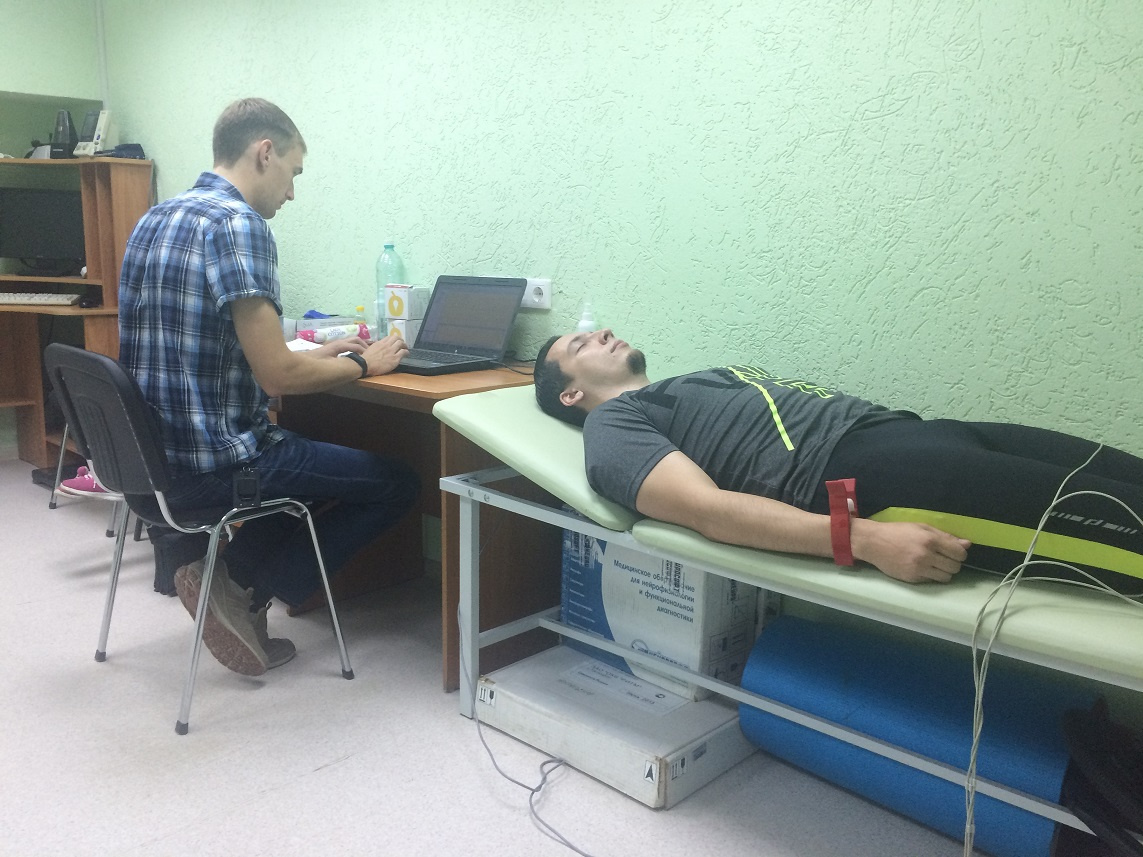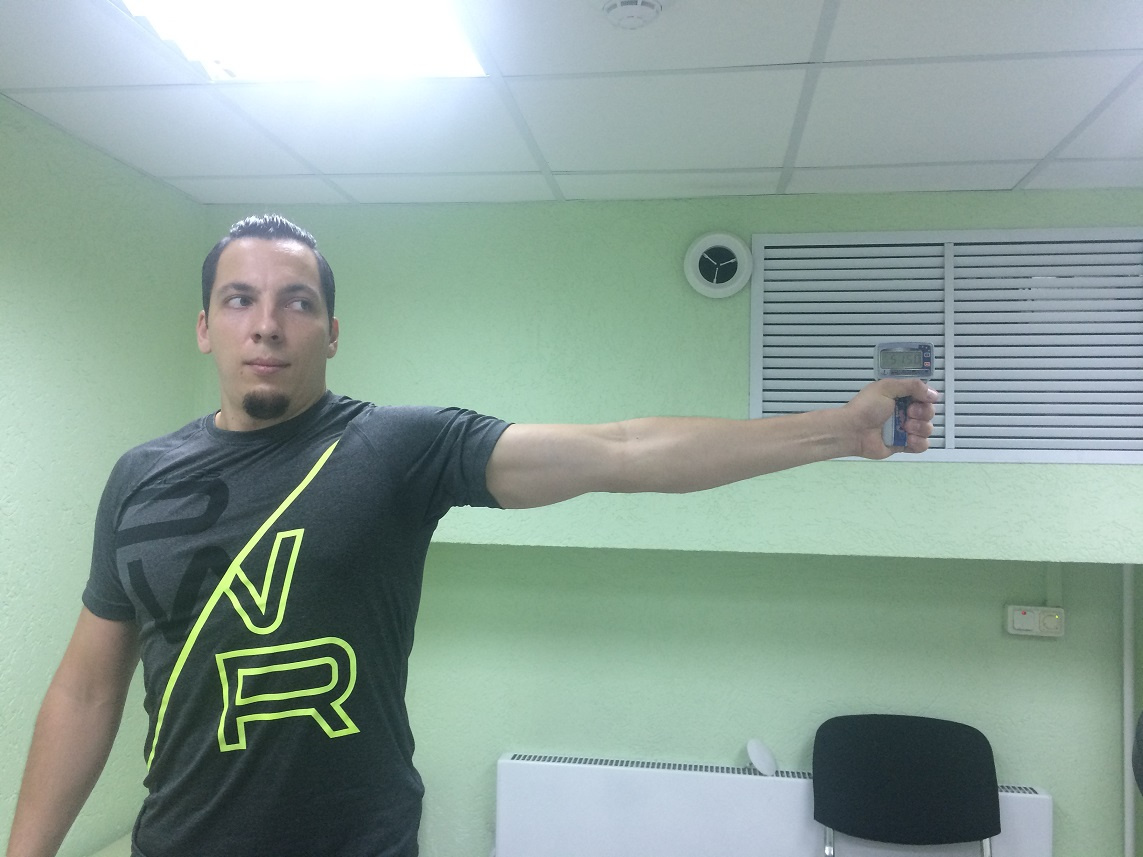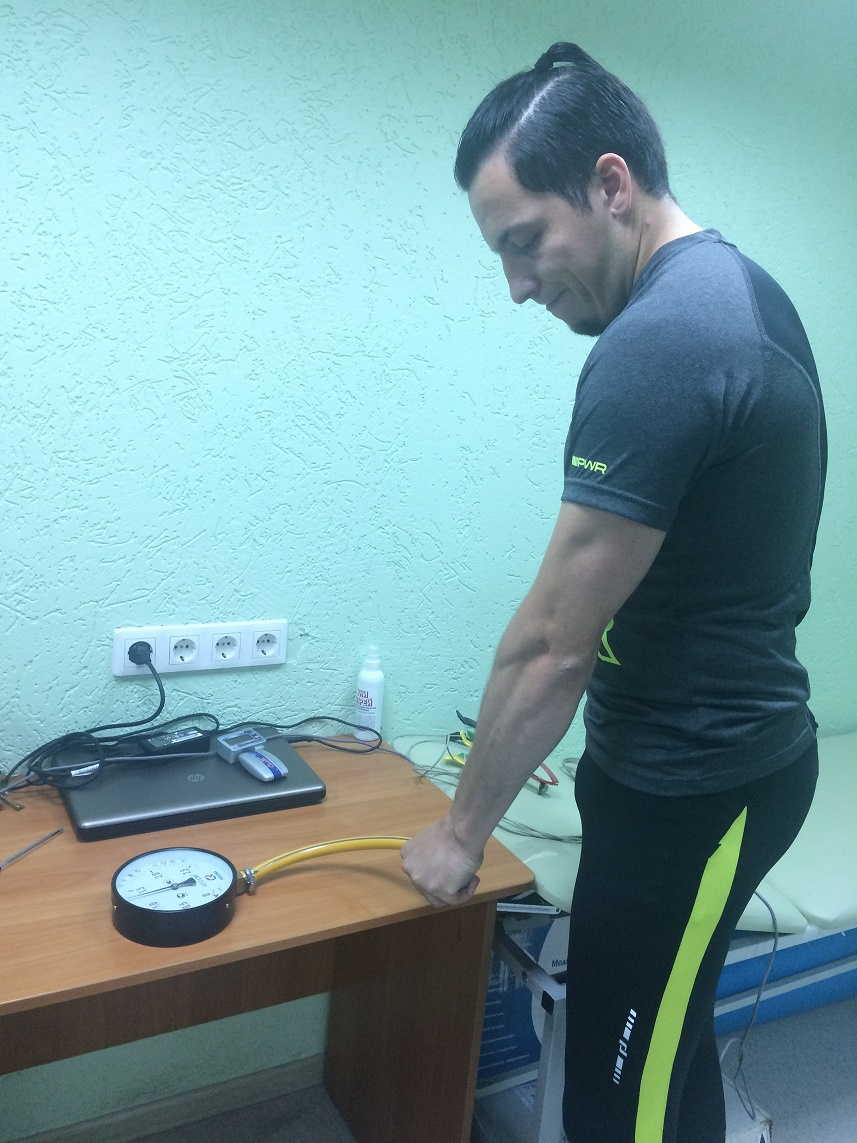How to train in running as efficiently as possible
We at EastBanc Technologies have decided to run a half marathon . Hired coaches, made training plans. And, of course, all at once were purchased with gadgets and pumped up beautiful mobile applications.
But the problem is that applications allow you to track only a picture of a specific workout, well, maximum after a while gather up statistics and create a clumsy individual plan. Training with a trainer is more effective, and it already protects you from injury and overtraining, but when you work in a team, the coach has to draw up an average plan for a spherical runner in a vacuum with average pulse zones. Therefore, it may happen that running at 4:00 for one member of the team will be restorative, and for the other exhausting.
In order not to guess, “Why did I pull my ankle in training and not my teammate,” our colleagues decided to go to physiologists from the Novosibirsk Pedagogical University to donate blood and measure ECG analog, because for now it’s the safest way to make -this individual training plan, taking into account all the problems of your body.
')

We have found the laboratory of the candidate of biological sciences Mikhail Golovin , who has been working with professional athletes and “civilians” for more than 7 years, studying the effects of stress on the body and giving recommendations for training. He tested our colleagues, and the results were so interesting and useful that they should definitely be shared with other IT people who, like us, suddenly got up from the table and ran.
You come to the laboratory, do a warm-up and start training, during which you measure everything you can. Here it should be noted that one day before the test, one cannot train, let alone compete - full rest is laid.
The main part of the test you run on treadmill or pedal on a bicycle ergometer. Runners are checked on a treadmill, cyclists - on a cycle ergometer, rowers - on a rowing simulator. This is very important, because if you run a cyclist on the track, he uses the wrong muscle group that is needed in his sport, and the result will be with great errors.
The load rises stepwise. First, an easy three-minute run, after which you stop, and the specialist takes 20 microliters of capillary blood from your finger from you.

Then you continue to run, the speed increases and - again blood sampling. Thus, the running speed is brought to submaximal values. That is, the pulse you, an amateur runner, should be about 85% of your maximum pulse. Professional athletes with experience are brought to a state when they go off the track.
The result is about 6-7 blood samples, which analyze the concentration of lactic acid (lactate) and glucose. These indicators characterize the intensity of aerobic, mixed and anaerobic processes.

Here we understand in more detail. Aerobic processes of energy production take place in the body, when you are running with comfort, no shortness of breath, the heart beats smoothly. The body does not experience a large oxygen debt, that is, oxygen is enough to oxidize the energy substances in the body (glycogen), as well as the oxidized metabolic products (lactate). The load at which the body goes aerobic processes, you can experience a long time without harm to health. This process is always with you: as long as you work, walk, breathe, blink, say you have aerobic processes in your body.
Mixed processes of energy production begin to be activated in the body when the power load increases, and aerobic energy is not enough. This usually occurs on a pulse of about 165-175, if the subject has a maximum heart rate of 180-190. In this mode, an amateur athlete is recommended to be once, a maximum of twice a week, about 10% of the total percentage of aerobic exercise. Exaggeration of this volume of mixed loads will lead to a serious physiological overload and depletion of the body. For an amateur athlete, the volume of loads is important, not intensity.
But the loads that trigger anaerobic processes, give a minimal effect to the stayers. In this state, the body does not have enough oxygen, it burns muscles, and wild fatigue cannot be endured for more than a few minutes. To achieve such a wonderful state, an amateur must develop a speed of 16 km / h and more. This is good for sprinters, because they have great muscle mass, short work intervals, a long rest period between exercise series, but are not suitable for stayers.
In addition, heart rate variability is determined by testing. In fact, a simple ECG plus measurement of the intervals between adjacent teeth of the cardiogram. This is done to assess the functional state of the cardiovascular system - the most sensitive marker of fatigue and overload.

Therefore, heart rate variability can be used as an overtraining criterion. Or insufficient reserves. When you are going to a training session in the morning, you can quickly measure the variability within 3-5 minutes, for example, using the Cardiobos or Welltory devices, compare them with the previous ones (each athlete should have a base of his old data) and evaluate how much and with what intensity you need to train today.
This is very important, because the variability does not always correspond to the subjective feelings, you may simply not know that today it is necessary to hold back the horses and do 70% of the usual workout. Also, this indicator is strongly influenced by the quality of sleep and the psycho-emotional state - once again during the training period it is better not to freak out or skimp on sleep.
Endurance and strength are evaluated, and the predisposition to sprint or longitudinal loads is calculated as a result. At first, you strongly compress the expander (dynamometer), on the strength of this compression, approximately 75% is taken, and now with this effort it is necessary to keep the second expander as long as possible. The ratio of the severity of endurance and strength allows you to calculate the severity of the muscle fiber and determine who you are - a sprinter, stayer or middle trainer.

Determination of maximum compressive force

Definition of endurance
The method of assessing the fatty component, based on the conduction of an electrical impulse through the body of the subject and the degree of current delay is proportional to the amount of fat. These are the smart scales that analyze body composition, and based on the result you get a recommendation to lose weight or gain weight and how.

When you are measured, at what load capacity, what processes start in your body, you can calculate the threshold of anaerobic metabolism, individual training zones and delineate the intensity of the load. So that YOU personally would not bother where it is useless for you, or even harmful.
This is the schedule that the subject receives, and in addition another comment from the expert who conducted the testing.

Clickable
In a healthy person, the glucose indicator should either remain at the initial level, or increase by the end of the load. The body has the ability to compensate for the needs of muscles and brain for energy, releasing it from the depot (from liver and muscle glycogen, as well as from fat deposits) a very large amount of carbohydrates, and you are bingo! - lose weight. If the glucose index decreases, this indicates a deficiency or depletion of carbohydrate depots.
Further from this graph it is clear that the subject is a middle actor, who is attached to the stayers. The maximum force of compression of the hands was 57 kg, the second expander held for 45 seconds. Calculate the fiber ratio, 57/45 = 1.26. Thus, it is possible to predict that the test subject has a good potential for perspective running for medium and long distances.
Another interesting feature that testing has revealed for this particular test subject is unusual training zones. If usually the average training zones are bounded above by the values of beats per minute: 140, 160, 180, then they are much higher. This means that he needs to train at high pulse values. The lactate data suggests that it will not overload on these zones, while working on generally accepted zones will not give him a strong development, and he will simply spend time on ineffective training. For example, if he runs developmental training on the pulse 155 (the upper limit of the developmental zone for a spherical 30-year-old person in a vacuum), he will not even come close to the developmental zone and will not exercise, but just have a good time in the fresh air.
Who is interested in the topic, here are a couple of graphs made on the basis of testing EastBanc Technologies employees.

Clickable
A woman was tested here, which can be seen in body weight and fat, asthenic-thoracic constitution (rather thin), visceral fat at a minimum, total fat is low, diets that exclude fats and carbohydrates are not recommended. Clean stayer. Very high training zones, which allows her to run on a high pulse. Carbohydrate depot well developed.

Clickable
And here we ran a man. Fat is at the upper limit of the norm, which is a hindrance in long-distance running. Mediocre, down to the stayers. The optimal distance to run in order to achieve the result is 3000-5000 meters. Training zones are slightly higher than the average.
Russia is obsessed with running: over the past 6 years, the increase in people who ran the marathon was 300%! Faster on these indicators now no country is growing.
Running is cheap, relatively easy to learn, and most importantly it introduces you to a huge community, to which thousands of IT professionals, directors, business owners, managers around the world already belong. That is, having run, you join a very good company.
But we at EastBanc Technologies, of course, did not focus on trends, but rather just wanted to do some big work together outside of work. Running really turned out to be the most accessible sport for the maximum number of employees. And according to the results of the trainings and the half marathon, they also decided to release the corporate calendar 2018, as we like to do.
There are 18 days left until the half marathon, and we are almost ready!



But the problem is that applications allow you to track only a picture of a specific workout, well, maximum after a while gather up statistics and create a clumsy individual plan. Training with a trainer is more effective, and it already protects you from injury and overtraining, but when you work in a team, the coach has to draw up an average plan for a spherical runner in a vacuum with average pulse zones. Therefore, it may happen that running at 4:00 for one member of the team will be restorative, and for the other exhausting.
In order not to guess, “Why did I pull my ankle in training and not my teammate,” our colleagues decided to go to physiologists from the Novosibirsk Pedagogical University to donate blood and measure ECG analog, because for now it’s the safest way to make -this individual training plan, taking into account all the problems of your body.
')

We have found the laboratory of the candidate of biological sciences Mikhail Golovin , who has been working with professional athletes and “civilians” for more than 7 years, studying the effects of stress on the body and giving recommendations for training. He tested our colleagues, and the results were so interesting and useful that they should definitely be shared with other IT people who, like us, suddenly got up from the table and ran.
What happens in testing
Test with increasing load
You come to the laboratory, do a warm-up and start training, during which you measure everything you can. Here it should be noted that one day before the test, one cannot train, let alone compete - full rest is laid.
The main part of the test you run on treadmill or pedal on a bicycle ergometer. Runners are checked on a treadmill, cyclists - on a cycle ergometer, rowers - on a rowing simulator. This is very important, because if you run a cyclist on the track, he uses the wrong muscle group that is needed in his sport, and the result will be with great errors.
The load rises stepwise. First, an easy three-minute run, after which you stop, and the specialist takes 20 microliters of capillary blood from your finger from you.
Then you continue to run, the speed increases and - again blood sampling. Thus, the running speed is brought to submaximal values. That is, the pulse you, an amateur runner, should be about 85% of your maximum pulse. Professional athletes with experience are brought to a state when they go off the track.
The result is about 6-7 blood samples, which analyze the concentration of lactic acid (lactate) and glucose. These indicators characterize the intensity of aerobic, mixed and anaerobic processes.
Here we understand in more detail. Aerobic processes of energy production take place in the body, when you are running with comfort, no shortness of breath, the heart beats smoothly. The body does not experience a large oxygen debt, that is, oxygen is enough to oxidize the energy substances in the body (glycogen), as well as the oxidized metabolic products (lactate). The load at which the body goes aerobic processes, you can experience a long time without harm to health. This process is always with you: as long as you work, walk, breathe, blink, say you have aerobic processes in your body.
Mixed processes of energy production begin to be activated in the body when the power load increases, and aerobic energy is not enough. This usually occurs on a pulse of about 165-175, if the subject has a maximum heart rate of 180-190. In this mode, an amateur athlete is recommended to be once, a maximum of twice a week, about 10% of the total percentage of aerobic exercise. Exaggeration of this volume of mixed loads will lead to a serious physiological overload and depletion of the body. For an amateur athlete, the volume of loads is important, not intensity.
But the loads that trigger anaerobic processes, give a minimal effect to the stayers. In this state, the body does not have enough oxygen, it burns muscles, and wild fatigue cannot be endured for more than a few minutes. To achieve such a wonderful state, an amateur must develop a speed of 16 km / h and more. This is good for sprinters, because they have great muscle mass, short work intervals, a long rest period between exercise series, but are not suitable for stayers.
Heart rate variability
In addition, heart rate variability is determined by testing. In fact, a simple ECG plus measurement of the intervals between adjacent teeth of the cardiogram. This is done to assess the functional state of the cardiovascular system - the most sensitive marker of fatigue and overload.
Therefore, heart rate variability can be used as an overtraining criterion. Or insufficient reserves. When you are going to a training session in the morning, you can quickly measure the variability within 3-5 minutes, for example, using the Cardiobos or Welltory devices, compare them with the previous ones (each athlete should have a base of his old data) and evaluate how much and with what intensity you need to train today.
This is very important, because the variability does not always correspond to the subjective feelings, you may simply not know that today it is necessary to hold back the horses and do 70% of the usual workout. Also, this indicator is strongly influenced by the quality of sleep and the psycho-emotional state - once again during the training period it is better not to freak out or skimp on sleep.
Method of assessing the type of functional response of the neuromuscular fiber
Endurance and strength are evaluated, and the predisposition to sprint or longitudinal loads is calculated as a result. At first, you strongly compress the expander (dynamometer), on the strength of this compression, approximately 75% is taken, and now with this effort it is necessary to keep the second expander as long as possible. The ratio of the severity of endurance and strength allows you to calculate the severity of the muscle fiber and determine who you are - a sprinter, stayer or middle trainer.
Determination of maximum compressive force
Definition of endurance
Bioimpedance analysis
The method of assessing the fatty component, based on the conduction of an electrical impulse through the body of the subject and the degree of current delay is proportional to the amount of fat. These are the smart scales that analyze body composition, and based on the result you get a recommendation to lose weight or gain weight and how.
So why know all these details about yourself?
When you are measured, at what load capacity, what processes start in your body, you can calculate the threshold of anaerobic metabolism, individual training zones and delineate the intensity of the load. So that YOU personally would not bother where it is useless for you, or even harmful.
This is the schedule that the subject receives, and in addition another comment from the expert who conducted the testing.

Clickable
What is interesting you can learn about the athlete from this schedule?
In a healthy person, the glucose indicator should either remain at the initial level, or increase by the end of the load. The body has the ability to compensate for the needs of muscles and brain for energy, releasing it from the depot (from liver and muscle glycogen, as well as from fat deposits) a very large amount of carbohydrates, and you are bingo! - lose weight. If the glucose index decreases, this indicates a deficiency or depletion of carbohydrate depots.
Further from this graph it is clear that the subject is a middle actor, who is attached to the stayers. The maximum force of compression of the hands was 57 kg, the second expander held for 45 seconds. Calculate the fiber ratio, 57/45 = 1.26. Thus, it is possible to predict that the test subject has a good potential for perspective running for medium and long distances.
Another interesting feature that testing has revealed for this particular test subject is unusual training zones. If usually the average training zones are bounded above by the values of beats per minute: 140, 160, 180, then they are much higher. This means that he needs to train at high pulse values. The lactate data suggests that it will not overload on these zones, while working on generally accepted zones will not give him a strong development, and he will simply spend time on ineffective training. For example, if he runs developmental training on the pulse 155 (the upper limit of the developmental zone for a spherical 30-year-old person in a vacuum), he will not even come close to the developmental zone and will not exercise, but just have a good time in the fresh air.
Another pair of charts
Who is interested in the topic, here are a couple of graphs made on the basis of testing EastBanc Technologies employees.

Clickable
A woman was tested here, which can be seen in body weight and fat, asthenic-thoracic constitution (rather thin), visceral fat at a minimum, total fat is low, diets that exclude fats and carbohydrates are not recommended. Clean stayer. Very high training zones, which allows her to run on a high pulse. Carbohydrate depot well developed.

Clickable
And here we ran a man. Fat is at the upper limit of the norm, which is a hindrance in long-distance running. Mediocre, down to the stayers. The optimal distance to run in order to achieve the result is 3000-5000 meters. Training zones are slightly higher than the average.
Why do we need a corporate half marathon?
Russia is obsessed with running: over the past 6 years, the increase in people who ran the marathon was 300%! Faster on these indicators now no country is growing.
Running is cheap, relatively easy to learn, and most importantly it introduces you to a huge community, to which thousands of IT professionals, directors, business owners, managers around the world already belong. That is, having run, you join a very good company.
But we at EastBanc Technologies, of course, did not focus on trends, but rather just wanted to do some big work together outside of work. Running really turned out to be the most accessible sport for the maximum number of employees. And according to the results of the trainings and the half marathon, they also decided to release the corporate calendar 2018, as we like to do.
There are 18 days left until the half marathon, and we are almost ready!



Source: https://habr.com/ru/post/336892/
All Articles